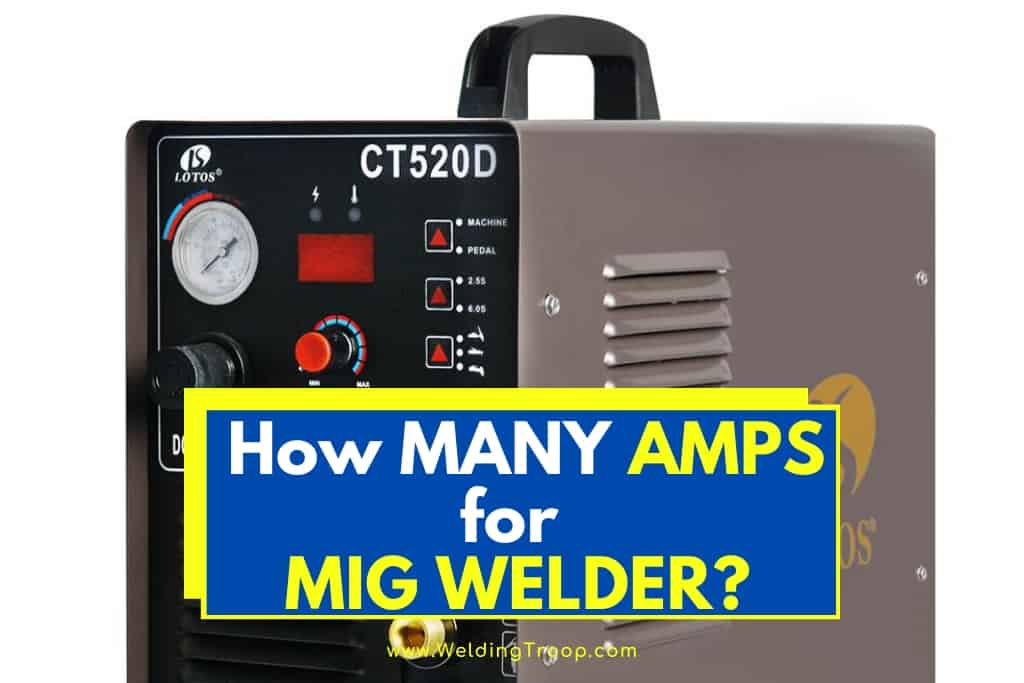Have you ever wondered how many amps do you need for a MIG welder? Few things are more important for welders than making sure that they have the proper amount of amperage.
Too little amperage and you might not be able to spark your welder to life, let alone have the heat and power necessary to melt and weld solid metal.
Too much and you might scorch the metal, cause the metal to bead, or overload the welder and potentially even cause it to explode.
How many amps do you really need for a MIG welder? In average you need 140 amps for 115 volts welders in order to weld up to ¼” thick steel and around 200 amps for 220 volts welders and weld up to ½” thick material.
Table of Contents
How Many Amps Do I really Need for a MIG Welder?
You need to remember that the amperage depends on many factors like the type and thickness of the material. how many amps for a welder?
The answer to that question will change depending on what type of welder you’re using.
MIG welding is the option of choice for many welders – especially beginners – which sparks another question – “how many amps to run a welder”
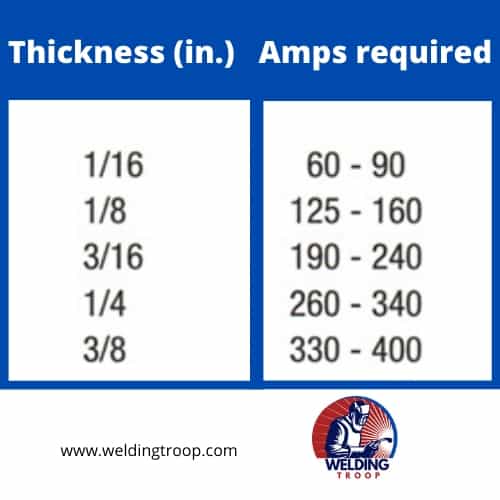
Are you going to be welding mild steel? Or do you anticipate working with stainless steel, aluminum, or an exotic metal or alloy?
What is the thickest thickness of the material that you expect to have to join? Knowing the answers to these questions will help you determine how much machine you need.
It’s always better to have a little bit more than you’ll need because even the kind of join that you’re welding can influence the amperage settings you’ll need to get the job done right.
Related reading: I have recently written an article in which I describe “5 Types of Welding Joints and Their Use – Complete Guide” in more detail, read this article here.
If you’re welding mild steel using stick welding techniques, the type of electrode that you’re using will influence the suggested amperage range.
E6013 is an all-purpose electrode that will weld 2mm mild steel with an amperage setting between 35 and 60.
At the same time, an E6010 or E6011 electrode will require a range of 40 to 85 amps.
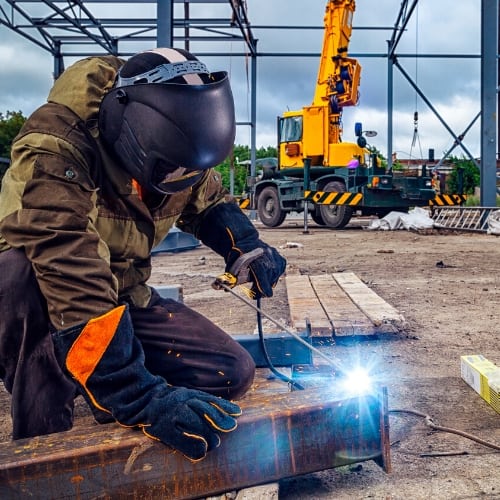
To TIG weld mild steel that is 2mm thick, you will need 60 amps for a closed root butt joint, 75 amps for a fillet joint, and only 55 amps for a lap joint or an outside corner.
For MIG welding mild steel, a good rule of thumb is to adjust the welder amperage level using one amp for every thousandth of an inch of thickness.
That would mean that 75 to 80 amps would be a good setting to start out on for mild steel that is 2mm in thickness.
The welder amperage range that is appropriate will change depending on the type of material you are welding and the thickness of that material.
So, you will need to take the range of materials that you want to be able to work on into consideration when you are determining how many amps you’ll need.
Let’s take a closer look at how amperage for welders work, the specifics of amperage and MIG welding, and how you can keep your unit at the right setting.
Type of Material
First and foremost, you’re going to want to consider what type of material you are welding. Different materials have different degrees of strength, and different metals have different melting points.
Those are a lot of points of differentiation, which means that you can’t and shouldn’t use the same amount of amperage for different materials.
Among the most common metals used in welding are aluminum, stainless steel, and low carbon steel.
For welding these as well as other metals, you’ll want to make use of a melting point calculator to determine how hot you need your welder to be to melt and weld it effectively.
There is also the fact that not all varieties of a given metal are created equally, or have the same welding properties.
For example, there are three basic types of stainless steel: austenitic, ferritic, and martensitic. You’ll want to differentiate between them when determining how much heat and, thus, the welder amperage is needed to effectively melt and weld with each.
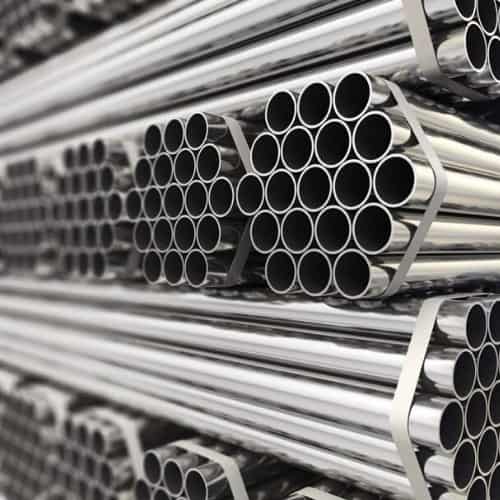
Intergranular corrosion occurs when stainless steels are exposed to high temperatures – like, say, in welding – which can in turn make them more difficult to weld.
While austenitic and ferritic stainless steels are generally very weldable, martensitic stainless steels are harder and are more liable to crack, thus, making them harder to weld with.
As a result, you may need more amperage to deal with them.
What about low carbon steel?
Well, if you’re looking for an easy-to-weld metal with a MIG welder, you’re in luck. Low carbon steel is highly weldable, requiring less effort, thus, amperage than other metals.
One reason for this is that its low carbon content makes it less ductile, which in turn makes it less brittle, thus, avoiding the cracking issues common in martensite stainless steel.
wire size
Select your wire size, according to amperage. We recommend not to change wire, therefore select your most commonly used thicknesses.
| Wire Size | Amps |
|---|---|
| .023 inch | 30-130 amps |
| .030 inch | 40-145 amps |
| .035 inch | 50-180 amps |
| .045 inch | 75-250 amps |
Set Your wire feed speed.
The amperage depends on wire speed as well as the amount of weld penetration.
Too high speed can lead to burn-through. We recommend to read your manual or the weld specification sheet.
As a general rule use the multipliers in the following table chart to determine your wire speed.
i.e, for .030-inch wire, multiply by 2 inches per amp to find the wire feed speed in inches per minute (ipm).
| Wire Size | Multiply by | using 1/8 inch (125 Amps) |
|---|---|---|
| .023 inch | 3.5 inches per amp | 3.5 x 125 = 437.5 ipm |
| .030 inch | 2 inches per amp | 2 x 125 = 250 ipm |
| .035 inch | 1.6 inches per amp | 1.6 x 125 = 200 ipm |
| .045 inch | 1 inch per amp | 1 x 125 = 125 ipm |
Material Thickness
Even if you are a beginner MIG welder, it shouldn’t come as too much of a surprise that thickness plays a huge role in determining how much heat, power, and, thus, amperage you need to weld something.
That said, while thickness is always significant, the actual amperage difference can vary a great deal depending on the type of metal being welded.
In the case of aluminum, for example, a good rule of thumb in TIG welding is 1 amp per 0.001 of thickness.
That said, this rule begins to break down at more than ¼ inch in thickness.
On the whole, the thicker the piece of aluminum, the less the amperage goes up. The same basic rule holds true for MIG welding as well.
The amperage for stainless and low carbon steel tends to be a bit less intense, requiring only 2/3 of an amp for every 0.001 of thickness, which works out to an average of around 40 amps per 1 mm.
Even thickness is dependent upon other factors; however, including the direction of the heat flow.
After all, the reason more amperage is needed at greater thicknesses is that more heat flow is needed to successfully melt and weld the area.
If some of that heat flow is dissipated, some of that heat is lost, and, thus, you will need even more heat than you might have needed if the flow had been more concentrated.
| Gauge | Metal Thickness (mm) | Metal Thickness (Inches) | Required Amps |
|---|---|---|---|
| 8 | 4,2 | .164 | 164 |
| 10 | 3,4 | .135 | 135 |
| 12 | 2,7 | .105 | 105 |
| 14 | 1,9 | .075 | 75 |
| 16 | 1,5 | .060 | 60 |
| 18 | 1,2 | .048 | 48 |
| 20 | 0,9 | .036 | 36 |
| 22 | 0,8 | .030 | 30 |
| 24 | 0,6 | .024 | 24 |
A good example of this is joints. In these pieces, the heat flow is dissipated out in the different directions to which the joints extend and attach to other pieces of metal.
As a result, the heat flow and, thus, amperage necessary to weld these pieces will be greater than their straight-edged counterparts.
Last, but not least, it is worth noting the amount of voltage you’ll need to power the welder itself. 110v per every 1/4in is a good metric with which to start your welding work.
How You Plan on Using the Welder
The thickness of the material that you’re welding is one thing, but what are you welding it for in the first place? The actual welding job you’re trying to perform can have a big impact on how many amps you need to power the unit.
If you are doing a job that requires extra power, you’re naturally going to need extra amperage.
Welding gates, machinery, and other things typical of farm work typically take an amp welder with at least 200v.
However, if you are looking to do higher-octane work, or are performing tasks that require a three-phase welder, you’ll need something with somewhere between 300 and 600 amps.
Related Article: What Gases Do MIG Welders Use >> Welding Shielding Gas | Complete Guide
On the other hand, if you are just using your MIG welder for hobbies or lower-level projects, you shouldn’t need that much amperage. A 110v machine that can produce 140 amps should be sufficient.
You’ll also want to think about where you’re using that welder. Most homes’ power sockets can support that 110v range, but above that, you’ll likely need to buy an adaptor or generator to make sure that your power source can handle the amount of amperage necessary for the job.
Related reading: Portable Welding Machine Buyer´s Guide: 5 Things To Look For
How Many Amps Does a Welding Machine Use?
Even if you were talking about a specific welding machine, the question of how many amps that it uses would still require a lengthy answer.
That is because almost any modern welding machine will have adjustable amperage settings that allow the user to fine-tune the machine’s function to make it more powerful when more power is required and easier to control when that is what the job calls for.
How many amps does a welding machine use? The answer depends on the machine that you are talking about. But some would argue that it isn’t even the right question to ask.
The number of amps that a welder needs to deliver depends on the kind of welding that is being done, the type of material or materials being welded, the thickness and cleanliness of the materials, and more.
It is easy to find welding machines that deliver what it takes to complete small jobs on lighter materials.
Often these machines are affordable, easy to set-up, easy to use, and easy to maintain.
But these machines tend to have limited power and typically aren’t what you’ll want if you’re doing jobs that are bigger, more technically complex, or involve challenging conditions.
Related reading: How Many Types of Welding Machines Are There And Their Uses?
How Much Amperage Should You Look for In A Welder?
Welding is one of the most useful skills that you can learn. Whether you want to make welding your primary occupation or just want to be able to make repairs to equipment around your farm or shop, there is a lot that can be accomplished with basic knowledge and skills.
Welding plays a role in everything from the arts to heavy industry. It makes sense that what works for modern sculpture isn’t the same as what works for shipbuilding or industrial ironworking.
One of the first questions you need to ask about a welding machine is whether you’ll be using it for a specialized task or whether you need it to be good for work as a generalist.
The type of work that you do will determine whether you want a MIG, TIG, or stick welder as well as how much power you need from the machine.
Higher amperage will give you more options, but it might come with tradeoffs like a higher price tag and lower portability that will make a high amp machine less desirable.
Higher amperage will give you deeper penetration that makes it possible to weld thicker materials and work faster and cleaner.
Amperage is also a key determiner of the duty cycle, which influences the amount of time that you can work before letting the machine rest.
If you’re shopping for a welding machine, you should ask how many amps you need as well as how many you’re able to run and how many your budget will permit.
By approaching your purchase this way, you’ll be able to find a machine that will do the jobs you need it to do without taking on the burden of rewiring your workspace or overspending your budget for no reason.
Questions to Ask Before You Purchase a Welding Machine
If you’re just getting into welding and haven’t settled into a preference, you will need to do some research.
There are at least three welding techniques that are common currently, and many high-end machines will give you the ability to use more than one technique. Some machines will even allow you to switch between all three.
Stick welding is probably the easiest and most basic technique to learn, but it is only easy in a limited number of circumstances, and it can be difficult to get good results on some materials or thicknesses.
MIG and TIG welding are a bit more complicated to learn, but they give welders a wider range of capabilities in terms of what they can work on and where they can work.
Whether you choose stick welding, MIG, or TIG, will help to determine how many amps you will need from your machine to be able to do the kinds of work that you want to do.
There are many jobs that you can do with any one of the three techniques, but the technique you use will help determine the amperage requirements for the job.
I have recently written an article in which I describe “the different types of welding machines and their uses” in more detail, read this article here.
How Many Amps Can You Run?
Welding machines that are powerful enough to deliver higher amperages are typically 3 phase machines that require access to three-phase power.
That isn’t an option for most homes or hobby shops. Even if a heavy-duty three-prong or four-prong outlet is available, you might still need to upgrade your circuit breakers before you can run a heavy-duty machine capable of delivering 300 to 600 amps.
Fortunately, 150 to 200 amps will be enough for the vast majority of welding tasks. That means that 115v or 220v outlets will be all that you’ll need to run your machine.
Unless you’re shopping for a machine that can run a 100% duty cycle on challenging materials, you should be able to get more than enough machine without getting into rewiring or major renovations.
How Many Amps Can You Afford?
When it comes to purchasing a welding machine, it pays to spend a little bit more to get more machine than you think you’ll need and make sure that it is a quality piece of equipment that will perform for a long time.
At the same time, it won’t do you any good to spend too much to get the biggest and best machine if you’ll never use half of the power or features that come with it.
Why Higher Amperage Matters
Having covered what factors contribute to the choice, it is worth taking a closer look at why higher amperage matters in the first place. While you don’t want to do things, higher amperes tend to be easier to work with.
There are several benefits of using higher amperages, not the least of which being that more amperage simply means more options.
The more heat and power you can generate, the greater your range of welding possibilities, which is always a good thing.
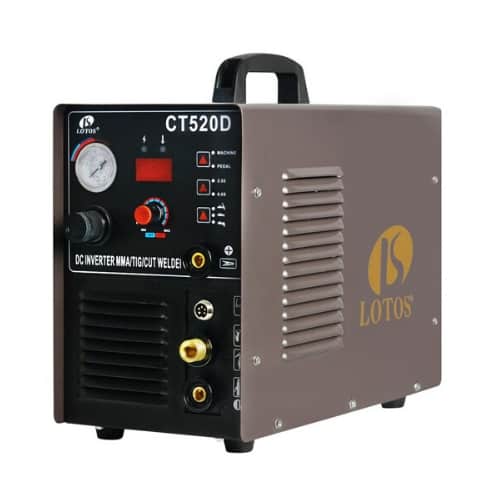
Then, there is the matter of actually penetrating the metal itself. The harder or thicker the metal is, the harder this will be, which will naturally require more effort on your part.
That said, this can get tedious and exhausting all too quickly. Besides, the amount of effort and strength you can personally give to the project is finite.
Adding extra amperage to the mix can, thus, be a great way to lessen the difficulty for yourself. After all, if there is more amperage and, thus, heat involved, the metal in question can be melted that much more quickly, thus, requiring less welding time from you.
Of course, you’ll need to make sure that you practice this in moderation. Adding too much amperage too quickly can cause burning and other severe safety issues. That said, practiced properly, more amperage means less toil.
This is especially true when welding thicker materials. As already mentioned, the thicker the metal, the more amperage it will take. Kicking that number up quicker while observing safety protocols can help you weld thicker and quicker.
Finally, there is the fact that higher amps provide greater consistency. At lower amperages, the work takes longer, which means there is more time to make mistakes.
Higher amperes expedite the process. They can also help you weld that much smoother. As a result, you can weld away all those little imperfections, producing work which is smoother, more consistent, and thus of greater quality.
By taking these factors into consideration, you can make sure that you are able to power your MIG welder with enough amperage to get the job done.
Can I Run A Welder On A 30 Amp Breaker?
Can I run a welder on a 30 Amp breaker? Yes, In the case of smaller welders with 115v, you will be able to run them on a 20 to 30 Amp breaker. For a 220v welder it is not possible to operate on low amperes and would require 30 amperes minimum but more than 30 amp is recommended.
In the end it all comes down to your usage and the intensity of the project. If you plan to use the MIG welder for smaller projects such as daily maintenance work around the house, then operation of small welder can work perfectly on a 30 Amp breaker.
However, it is important to note that a 30 Amp breaker will not trip if you hit 30 Amp limit but it will lessen the time period for it.
How Thick Can A 180 Amp MIG Weld?
How thick can a 180 Amp MIG weld? A 180 amperes MIG welder is qualify for welding up to 0.035 inch. In some cases, ½ of an inch can be welded. However, its penetration level is not as effective.
Thicker than the mentioned parameters (0.035 inch) would adversely affect the penetration level hence requiring a lot more effort.
When it comes to MIG welder amps steel thickness it’s important to understand that welders utilizing single pass are 1 ampere per 0.001 inches of thickness. This can also be understood as 250 amps per every 1/4th of an inch.
How Thick Can A 70 Amp Welder Weld?
How thick can a 70 Amp welder weld? 70 Amp welders are perfect for welding up to 1/8 inch thick sheets. This proves a 70 amp to be the best match for intricate work and small welding projects.
70 Amp welders are small and portable welders that are extremely convenient when it comes to using it for lightweight purposes.
Although 70 Amp welders are not heavy duty, it helps in performing small tasks around the house and gives you the choice for electrode attachments and earth systems.
It should be kept in mind that while 70 Amp welding machines are on the more durable and affordable end, they are extremely challenging to control and it will require time in both learning the machine and the process of welding with it.
How Many Amps Does A Lincoln 225 Welder Pull?
How many amps does a Lincoln 225 welder pull? As the name suggests, Lincoln 225 Welder pulls up to 225 amperes. Lincoln 225 Welder provides you with the range of 40 to 225 ampere pull without overloading the machine.
This welder is known to be one of the most powerful machines providing you with maximum versatility.
It’s designed for operating on metals that are 16 gauge or heavier. The smooth AC arc allows this machine to be used on a variety of metals.
The full range of 40 to 225 ampere selector switch enables you to quickly set the wielding current according to your project.
Any lesser than 40 amperes may not allow the machine to be used at its maxi mum capacities so always ensure that current pull is between the mentioned ranges.
How Thick Can You Weld With A Hobart 140?
How thick can you weld with a Hobart 140? Since the Hobart 140 has generous operating parameters, it enables you to weld from thin gauge steel as little as 24 gauge up to a whopping ¼ inch steel plate.
While you can weld in the given range in a single pass, Hobart 140 allows you to weld thicker materials with multiple passes as well.
The Hobart 140 is one of the most versatile machines due to its compactness and effective design.
It is a wire feed MIG welder designed to run on the household standard of 115 V of power.
It’s relatively easier to set up and runs flux-cored steel, solid and aluminum wire.
Its range for thickness allows you to work on auto bodies, household repairs, or even heavy-duty projects that would require extra power.
If you are interested in welding gear or tools, then just follow the link to our recommendation page where you can see all welding accessories we love and use (NO CRAP)
+ Highest Quality
+ Tested & Approved
+ Affordable Machine
+ Right Balance Between Quality & Price
Frequently Asked Questions
Here are a few common questions people often have about MIG welder Amps:
Can I Put A 50 Amp Plug On A 30 Amp Breaker?
The breaker capacity defines the limit of current withdrawal. For any breaker it is recommended that no more that 80% of the actual breaker capacity is used.
Can I put a 50 Amps plug on a 30 Amp breaker? No. 30 ampere breaker defines the limit at 30 amperes strictly so you should not be using more than 24 to 25 amperes when using a 30 Amp breaker.
You should not exceed the capacity of the circuit through the usage of high ampere requiring machinery. This will not only cause the circuit to malfunction but could also potentially damage your device.
Can You Plug a 15 Amp Plug Into a 20 Amp Receptacle?
The receptacle value is always supposed to be higher than the plug that is being connected to it. Most household appliances include a 15 amp plus that makes them eligible to be used in 15 or 20 amp receptacle.
Can you plug a 15 Amp plug into a 20 Amp receptacle? Yes, you can do it. A 15 amp plus has two parallel blades and a ground pin that can easily be plugged into a 20 amp receptacle.
The 20 amp receptacle provides you with a diverse range of choices when it comes the plug being used but it should always be noted that the ampere limit should not be exceeded.
A 20-amp receptacle accommodates larger influx on current and enables you to use more heavy-duty appliances. Larger power tools including welding machines can be used with a 20 amp receptacle.
How Many Amps Does A Lincoln 140 Use?
How many amps does a Lincoln 140 use? This machine proves itself to be robust and reliable through its 140 Amp tool that gets the job done on normal household power of 120 volts.
It comes in two variants called 140 HD and 140 C hat both share the same ampere usage but differ in componential qualities.
Despite them being variants, both welders all you to withdraw up to 140 amperes with no problem.
The minimum ampere requirement is 30 amperes and allows you to weld up to 5/16 inch for mild steel without gas and MIG welding up to 3/16 inch in a single pass with gas.
Lincoln 140 is one of the top tier welding machines available on the market.
Conclusion
When it comes to welding, there aren’t many simple answers. That’s because so much of what you need to know to find the right answer depends on variables like the type of work you’re doing and the type of materials you’re welding.
If you know that you have enough welding work to do that you are considering investing in a machine, you should know the specific answers to those questions that will allow you to determine how much machine is enough and how much is too much.
sources:
https://www.millerwelds.com/resources/weld-setting-calculators/stick-welding-calculator
https://www.mig-welding.co.uk/tig-calculator.htm
Recommended Reading
Can You MIG Weld in the Rain or when it’s wet?
What’s the Difference Between TIG and MIG Welding? Which one is better?
Can MIG Welders Weld Aluminum? | How to successfully weld Aluminum?
How To Find The Correct MIG Welder Settings For Any Project >> Video
Here are some of my favorite tools & equipment´s
Thank you for reading this article. I hope it helps you find the most recent and accurate information for your welding project. Here are some tools that I use daily and hope you´ll also find helpful.
There are affiliate links, so if you do decide to use any of them, I´ll earn a small commission. But in all honesty, these are the exact tools that I use and recommend to everyone, even my own family. (NO CRAP)
To see all my of most up-to-date recommendations, check out this resource that I made for you!

